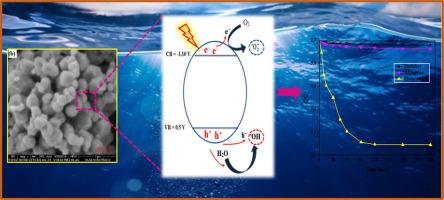CoMn2O4: a straightforward manufacturing method for effective acebutolol removal upon visible light
IF 4.7
3区 化学
Q2 CHEMISTRY, PHYSICAL
Journal of Photochemistry and Photobiology A-chemistry
Pub Date : 2025-09-18
DOI:10.1016/j.jphotochem.2025.116795
引用次数: 0
Abstract
There is a significant worldwide worry regarding pollution caused by pharmaceuticals. Therefore, it is of utmost importance to develop an efficient preventive approach to address this situation. Herein, CoMn2O4 was synthesized through a co-precipitation technique. To comprehensively investigate the crystalline phase, morphology, microstructure, and optical and electrochemical properties of the manufactured photocatalyst, multiple methodologies were employed. The photocatalytic efficacy of the obtained CoMn2O4 sample was assessed by decomposing acebutolol (ACB) under visible lighting exposure. After 180 min of illumination, the results revealed that CoMn2O4 exhibited exceptional efficacy, with an improvement of 91.3 %, approximately 78.44 and 40.25 times higher than photolysis and adsorption alone, respectively. The catalyst exhibited excellent stability and reliability, maintaining substantial performance across 5 successive cycles. Scavenger experiments revealed that hydroxyl radicals (•OH) and superoxide radicals •O2− are the primary reactive species that trigger the decomposition of acebutolol, whereas holes (h+) and electrons (e−) contribute to a lesser extent. Crucially, based on the data, a plausible mechanism for ACB decomposition was proposed. Crucially, the biocompatibility of the ACB solution following treatment with CoMn2O4 was examined by growing lentil seeds. Given its straightforward manufacturing method and remarkable efficacy, the generated CoMn2O4 photocatalyst is appropriately suited for wastewater detoxification. This design approach opens new possibilities for creating highly efficient photocatalysts and lays the groundwork for future progress in the promising field of environmental remediation. This research sets the stage for manufacturing innovations in the near future.

CoMn2O4:一种在可见光下有效去除乙丁醇的直接制造方法
药品造成的污染是全世界普遍担忧的问题。因此,极为重要的是制订一种有效的预防办法来处理这种情况。本文采用共沉淀法合成了CoMn2O4。为了全面研究制备的光催化剂的晶相、形貌、微观结构以及光学和电化学性能,采用了多种方法。通过在可见光照射下分解乙酰丁醇(ACB)来评价CoMn2O4样品的光催化效果。光照180 min后,CoMn2O4表现出优异的效果,比光解和吸附分别提高了91.3%和约78.44倍和40.25倍。催化剂表现出优异的稳定性和可靠性,在连续5次循环中保持了可观的性能。清道夫实验表明,羟基自由基(•OH)和超氧自由基•O2−是引发乙酰丁醇分解的主要活性物质,空穴(h+)和电子(e−)的作用较小。关键是,基于数据,提出了一种合理的ACB分解机制。最重要的是,用CoMn2O4处理ACB溶液后,通过生长小扁豆种子来检测其生物相容性。合成的CoMn2O4光催化剂制备方法简单,效果显著,适合用于废水脱毒。这种设计方法为创造高效光催化剂开辟了新的可能性,并为未来在有前途的环境修复领域的进展奠定了基础。这项研究为不久的将来的制造业创新奠定了基础。
本文章由计算机程序翻译,如有差异,请以英文原文为准。
求助全文
约1分钟内获得全文
求助全文
来源期刊
CiteScore
7.90
自引率
7.00%
发文量
580
审稿时长
48 days
期刊介绍:
JPPA publishes the results of fundamental studies on all aspects of chemical phenomena induced by interactions between light and molecules/matter of all kinds.
All systems capable of being described at the molecular or integrated multimolecular level are appropriate for the journal. This includes all molecular chemical species as well as biomolecular, supramolecular, polymer and other macromolecular systems, as well as solid state photochemistry. In addition, the journal publishes studies of semiconductor and other photoactive organic and inorganic materials, photocatalysis (organic, inorganic, supramolecular and superconductor).
The scope includes condensed and gas phase photochemistry, as well as synchrotron radiation chemistry. A broad range of processes and techniques in photochemistry are covered such as light induced energy, electron and proton transfer; nonlinear photochemical behavior; mechanistic investigation of photochemical reactions and identification of the products of photochemical reactions; quantum yield determinations and measurements of rate constants for primary and secondary photochemical processes; steady-state and time-resolved emission, ultrafast spectroscopic methods, single molecule spectroscopy, time resolved X-ray diffraction, luminescence microscopy, and scattering spectroscopy applied to photochemistry. Papers in emerging and applied areas such as luminescent sensors, electroluminescence, solar energy conversion, atmospheric photochemistry, environmental remediation, and related photocatalytic chemistry are also welcome.

 求助内容:
求助内容: 应助结果提醒方式:
应助结果提醒方式:


